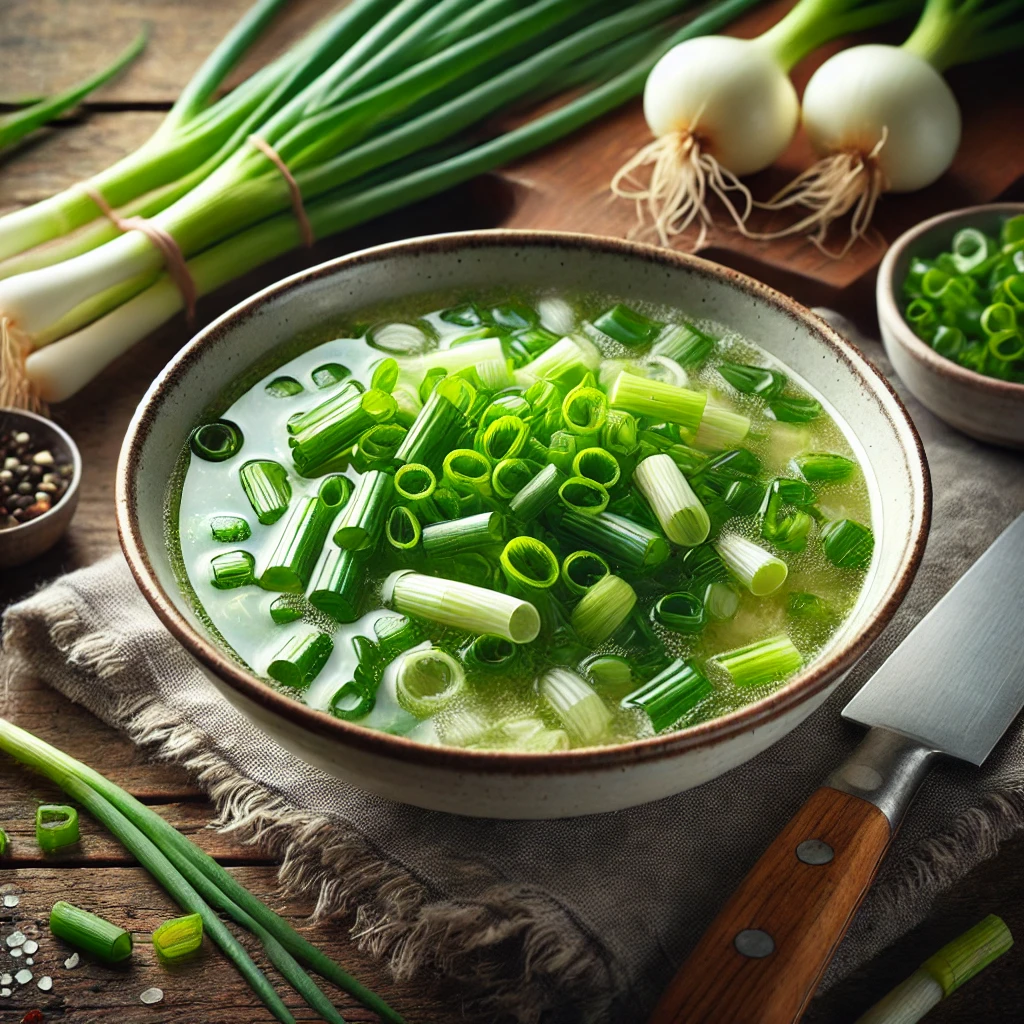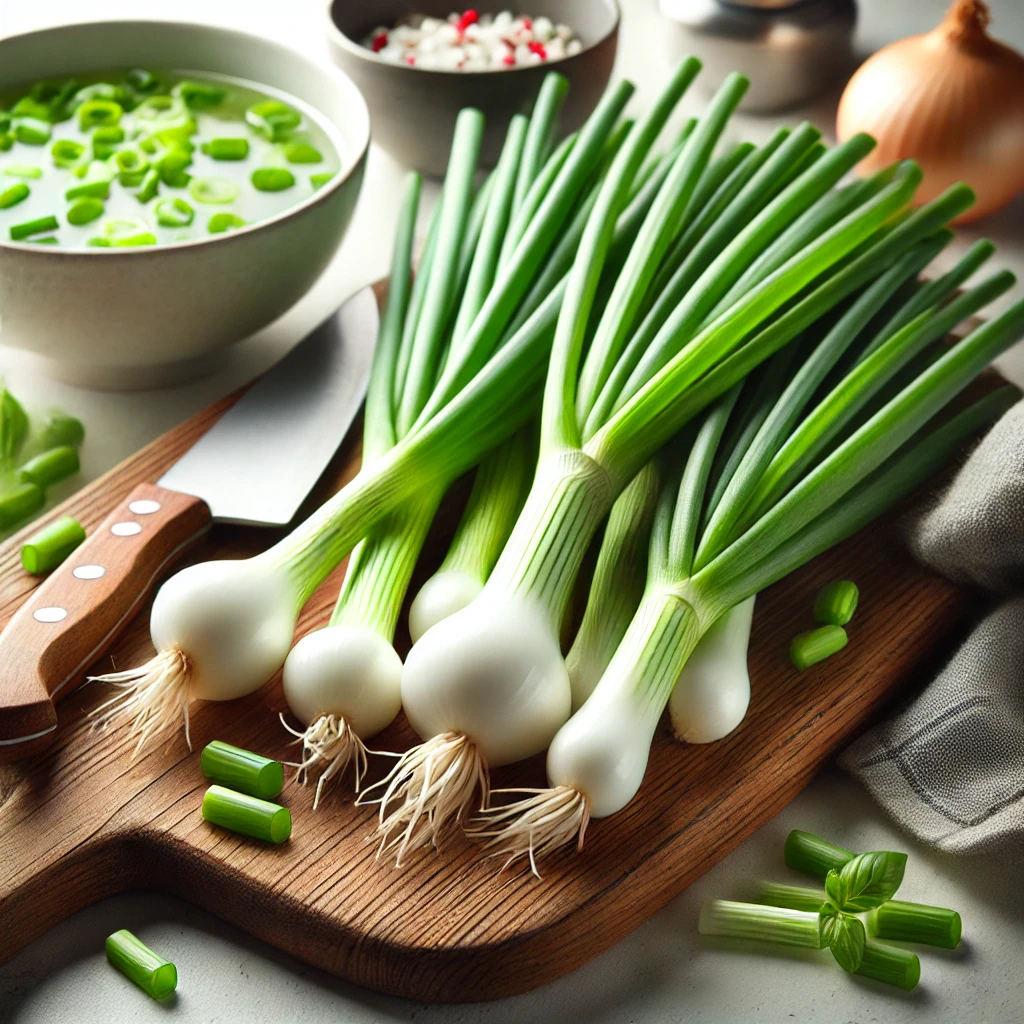Green onions, also known as scallions, are a versatile and flavorful ingredient in many cuisines. In soups, they can enhance the dish with their fresh, mild onion flavor while also adding a pop of color and texture. However, a common question arises: What part of the green onion should you use for soup? The answer depends on the type of soup and the role you want the green onion to play in your dish.
Table of Contents
ToggleThe Two Main Parts of a Green Onion
Green onions are composed of two distinct parts:
- White Bulb: The lower portion, near the roots, is firm and has a stronger, more onion-like flavor.
- Green Tops: The upper part is tender, mild, and slightly grassy in flavor.
Both parts are edible and serve different purposes in cooking, especially in soups.
Using the White Bulb for Soup
Characteristics:
- The white bulb has a concentrated onion flavor and a crisp texture.
- It is often used as a base ingredient for building flavor in soups.
How to Use It:
- Sautéing: Dice or slice the white part and sauté it with garlic, ginger, or other aromatics at the beginning of the cooking process. This step infuses the soup with a deeper flavor.
- Boiling: Add sliced white bulbs directly into the soup for a more robust onion taste as it simmers.
Best for:
- Hearty soups like chicken noodle or miso soup.
- Creamy soups where a strong aromatic base is required.
- Broths that need depth without overpowering the other flavors.
Using the Green Tops for Soup
Characteristics:
- The green tops are milder and softer, with a delicate, grassy flavor.
- They are often used as a garnish or added at the end of cooking.
How to Use It:
- Garnishing: Finely chop the green tops and sprinkle them over the soup just before serving for a fresh burst of flavor and color.
- Stirring In: Add chopped green tops to the soup during the last minute of cooking to retain their bright flavor and texture.
Best for:
- Clear soups, like wonton or egg drop soup, where a fresh garnish is desired.
- Light vegetable soups where the focus is on fresh ingredients.
- Asian-style soups where green onions are traditionally used as a topping.
Using Both Parts Together
In many soups, both the white and green parts of the green onion can be used to achieve a layered flavor profile:
- White Bulb for Cooking: Use the white part early in the process for a strong base.
- Green Tops for Garnish: Reserve the green tops for a fresh finish.
This combination works particularly well in soups like:
- Ramen
- Pho
- Chicken or vegetable broth-based soups

How to Prepare Green Onions for Soup
- Clean Thoroughly: Rinse the green onions under cold water to remove dirt, especially near the roots.
- Trim the Ends: Cut off the root ends and any dried tips of the green tops.
- Separate the Parts: Slice the white bulb and green tops separately to use them at different stages of cooking.
Tips for Maximizing Flavor with Green Onions
- Avoid Overcooking the Green Tops: Adding the green tops too early can cause them to lose their vibrant color and delicate flavor.
- Pair with Other Aromatics: Green onions work well with garlic, ginger, celery, or leeks to create a rich soup base.
- Use as a Base or a Finish: The white part adds depth when cooked, while the green part adds freshness and visual appeal.
Substitutes for Green Onions in Soup
If you don’t have green onions on hand, try these substitutes:
- Leeks: Use the white and light green parts for a similar mild onion flavor.
- Chives: These make a great garnish, similar to the green tops of green onions.
- Shallots: Finely chop and sauté for a stronger flavor.
- Yellow Onions: Use sparingly, as they have a much stronger flavor than green onions.
Common Soups That Use Green Onions
- Egg Drop Soup: The green tops are used as a garnish to add freshness and color.
- Miso Soup: Both the white and green parts are used for layers of flavor.
- Pho: Green onion tops are often added as a garnish alongside cilantro and basil.
- Chicken Noodle Soup: The white part can be sautéed with other vegetables for a flavorful base.
- Ramen: Thinly sliced green tops add a bright, fresh contrast to the rich broth.
FAQs About Using Green Onions in Soup
1. Can I use the entire green onion in soup?
Yes, both the white and green parts are edible and can be used at different stages of the cooking process.
2. Should I add green onions at the beginning or end of cooking?
- Use the white bulb at the beginning for a strong base flavor.
- Add the green tops at the end for freshness and garnish.
3. Can green onions be used in creamy soups?
Absolutely. The white bulb can enhance the flavor base, while the green tops can add a fresh finish.
4. Are green onions the same as scallions?
Yes, green onions and scallions are the same vegetable and can be used interchangeably.
5. Do green onions lose their flavor when cooked?
The green tops can lose their delicate flavor if overcooked, but the white bulbs maintain their flavor well.
6. Can I freeze green onions for soup?
Yes, green onions can be chopped and frozen. Use them directly from the freezer for cooking (not garnishing).
7. How do I store green onions for freshness?
Wrap them in a damp paper towel and place them in a plastic bag in the fridge. They’ll stay fresh for up to a week.
8. What’s the best knife for cutting green onions?
A sharp chef’s knife or a small paring knife works best to avoid crushing the delicate green tops.
9. Are green onions spicy like regular onions?
No, green onions have a milder flavor compared to yellow or red onions.
10. Can I use only the green tops and discard the white bulb?
Yes, if you prefer a milder flavor, you can use only the green tops.
Green onions are a simple yet powerful ingredient that can elevate your soup, whether you’re making a hearty chicken noodle soup or a light, clear broth. By using both the white and green parts wisely, you can achieve the perfect balance of flavor, texture, and visual appeal. Happy cooking!

